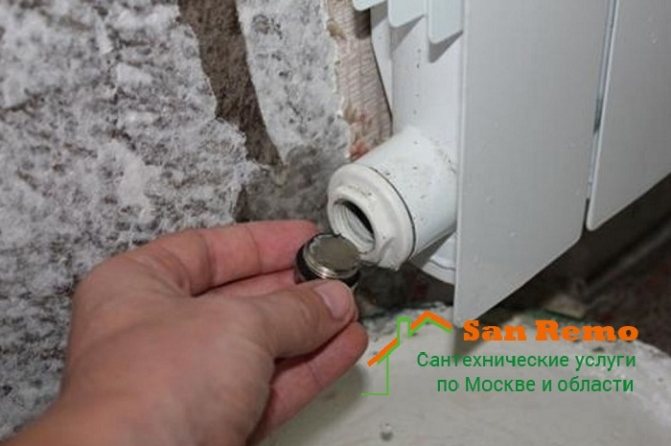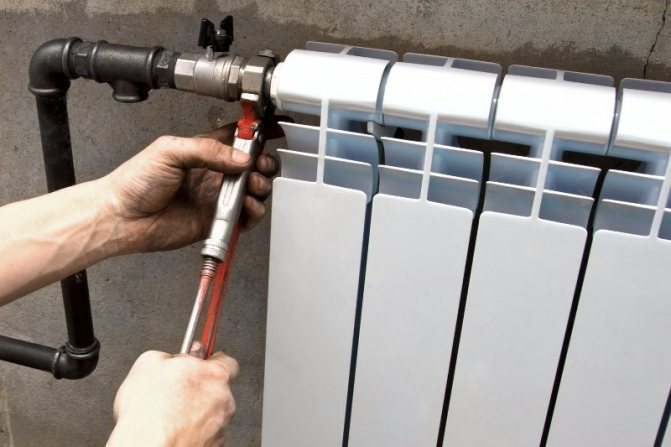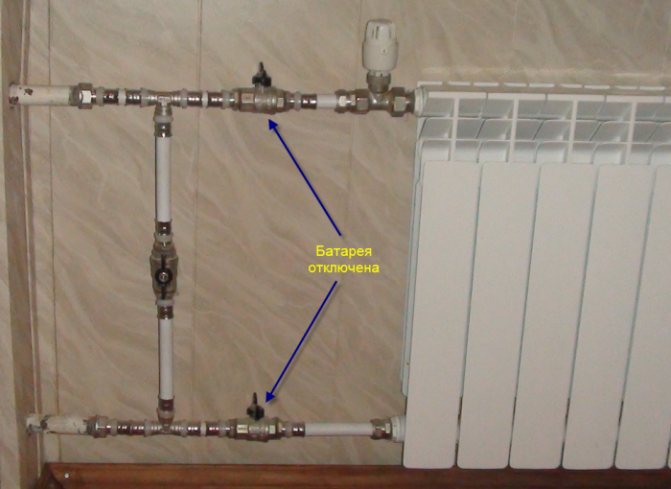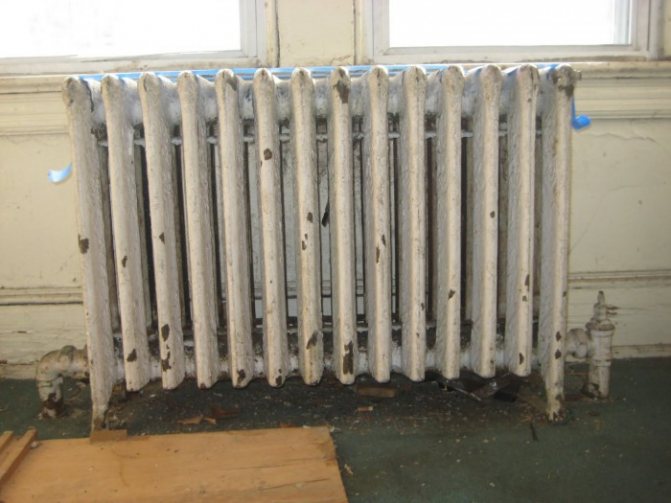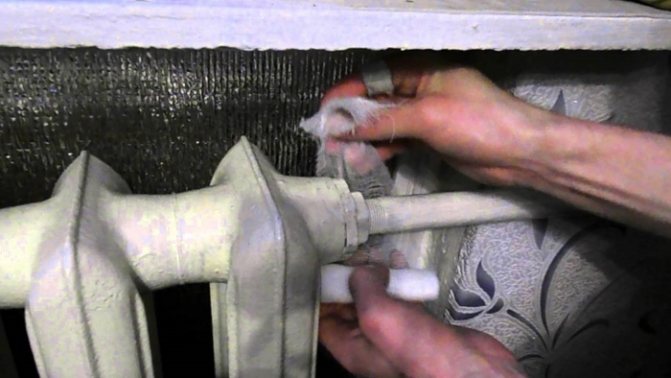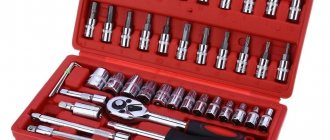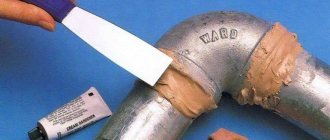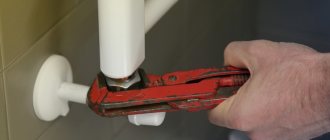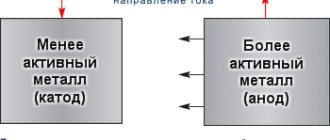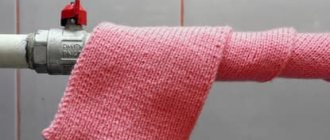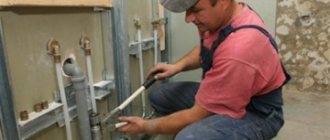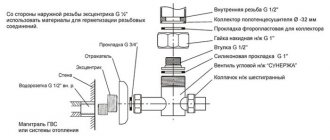Any engineering communications, including heating systems, gradually wear out and fail. Malfunctions are of a different nature, but when the heating battery leaks, this leads to unpleasant consequences. The sooner the leak of a cast-iron, steel or bimetallic radiator is eliminated, the less likely it is to flood your apartment and flood your neighbors.
- Why are heating radiators leaking?
- A heating radiator is flowing: what to do
- How to fix a leak in a weld
- Eliminate leakage between battery sections
- How to repair a leak in a heating battery: repair methods
Why is the heating battery leaking
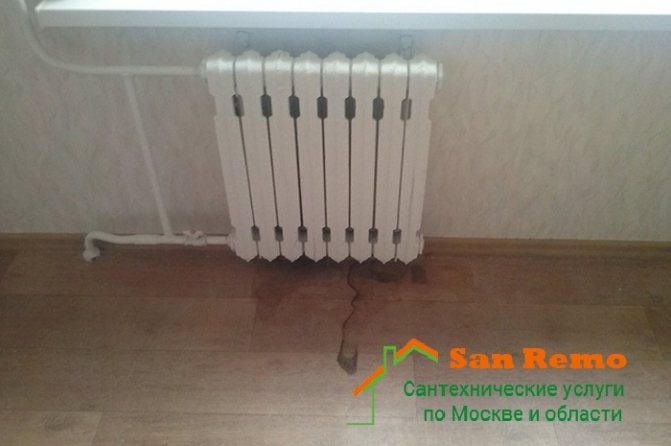
Before figuring out how to fix a radiator leak between sections or in another place, you need to understand the causes of the problems that arise:
- Cast iron radiators are heavy and mounted on strong hooks. With a minimum error, the radiators sag under their weight, and a misalignment of a few millimeters causes the formation of air pockets. In these places, corrosion begins - the cast iron becomes thinner and after a while a fistula forms. A slight leak appears, which it is desirable to quickly eliminate.
- In houses with a centralized heating system, water shocks often occur, due to which sometimes heating batteries leak at the joints (this is especially true for bimetallic radiators).
- Pig-iron radiators are rough inside, so all kinds of debris and foreign inclusions are retained on the surface: pieces of metal, rusty sediment, etc. Gradually, the channels begin to clog, and the deterioration in the circulation of the coolant leads to the risk of a breakthrough or leakage. This is another reason why batteries, both cast iron and steel, leak.
- Gaskets and nipple threads are weak points of heating radiators, therefore, leakage can form in these places.
When calling the master online
Practice shows that the leakage of aluminum, steel and other radiators does not appear suddenly. First, characteristic signs appear: the air temperature in the room decreases, a deposit forms on the radiator, and corrosion spots form on the surface.
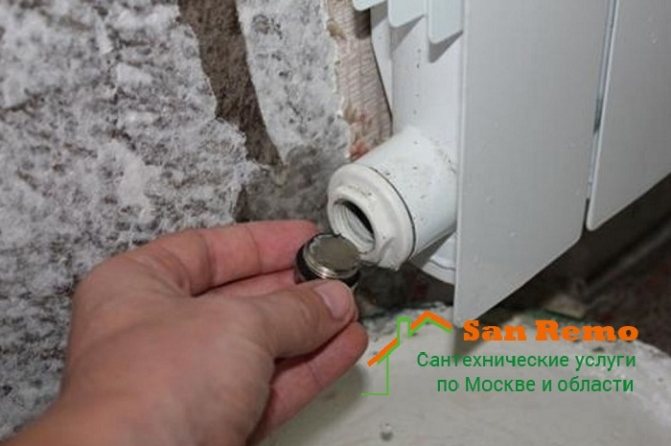

Don't be idle when you see these signs, but decide what to do - the battery is already leaking. If you ignore the situation, an accident may occur. Also, soon you may find a puddle of water under the radiator, and the level of humidity in the room will noticeably increase. You can repair the leak in the heating radiator yourself or contact the craftsmen. An experienced plumber of our company will quickly eliminate the leakage of any radiator: aluminum, steel, bimetallic, cast iron.
Many are worried about the question, if the battery is leaking, who to call? If you live in an apartment with central heating, contact the management company or us. In other cases, you can do without the management organization - it will not help you.
Frequently asked Questions
Homeowners have the same questions about how to solve these problems.
Often interested in the following:
- where to go if the battery leaks;
- what to do if there is no way to shut off the water;
- who is to blame if the neighbors are flooded.
Where to go if the heating battery leaks?
For apartment owners in multi-storey buildings, it makes sense to call a plumber by contacting the housing and communal services service, HOA or management company. Emergency telephone numbers should be posted in the entrances. There is an option to call an employee of a private company that provides such services. In a private house, you will have to deal with the problem yourself.
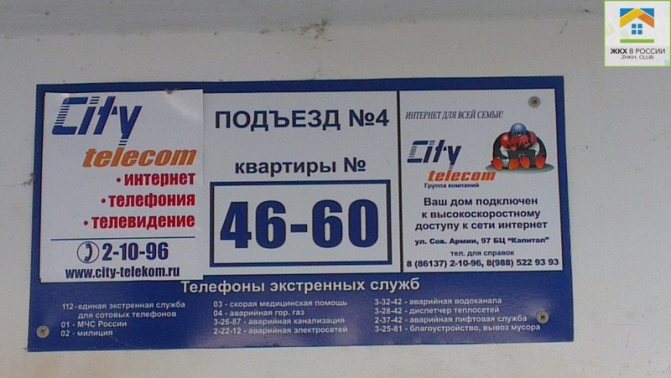

How to eliminate a radiator leak without shutting off the water?
If the cause of the leak is a crack in the pipe, it can be wrapped with rubber and tightened from above with any clamp or wire. If this is a small sink, then you need to take a self-tapping screw for metal with a rubber washer and screw it in with a screwdriver. These measures are effective only at low pressure in the circuit. After manipulation, you need to turn on the pump and make sure that the repaired place can withstand the water pressure in the system.
When radiators are leaking in an inaccessible place and the leak is small, then mustard should be added to the expansion tank. Substitute a container under the dripping unit, increase the temperature of the water in the system. Mustard powder, like a liquid sealant, will close it when it reaches the leak. Ready-made liquid sealants are available for sale just for such cases. Add them to the system, and all small leaks will cease to bother you.
Who is to blame if the heating pipe burst and the neighbors were flooded?
The landlord, when hot water bursts out in all directions, panic. Until you reach the tap, the entire floor will be flooded. And the floor of the room serves as a ceiling for the neighbors below. You can localize a leak by throwing any thick rag over the breakout site. Water will flow down through it, where you substitute a basin. This will give time to turn off the water and turn off the pump, if any.
When your apartment has centralized heating, the algorithm is different.
A breakthrough in the heating system can happen at any time of the year. The management company must carry out technical tests of the pipes before the heating season. To do this, they are checked by applying high pressure. Tenants should be warned about this. If a breakthrough occurred as a result of such a procedure, then the actions are as follows:
- If at the time of the breakthrough you are at home, then shut off the water.
- Call the contact phone to the management company and report the incident.
- Capture on a photo or video:
- place of damage (breakthrough);
- the consequences of flooding: damaged property in your apartment;
- damaged property and belongings of neighbors.
- Achieve the drawing up of an act.
Sometimes citizens think that it is better to install air conditioners and turn them on for heating than to compensate for the damage to their neighbors. Air conditioners are not designed to operate in temperatures exceeding -4 ° C. Condensate freezes in the drain pipe, the outdoor unit suffers, and the device may fail. It is best, if possible, to install individual heating. In this case, it is necessary to replace the metal pipes with plastic ones and install aluminum radiators.
How to fix a leak in a heating radiator
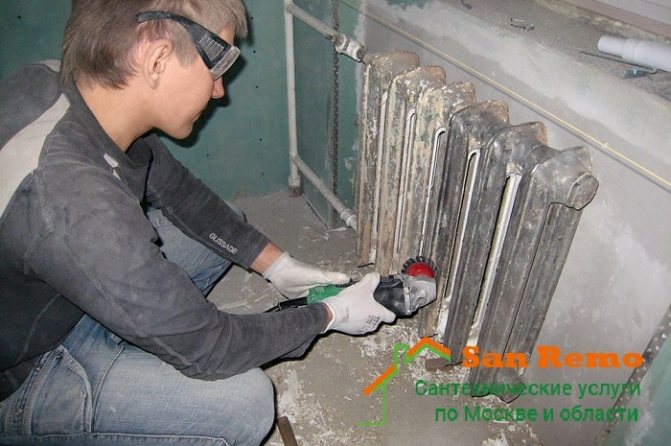

What to do when the radiator begins to ooze at the joints, between adjacent sections, or a tap is leaking? Many people, finding a leak, get lost and do not understand what to do. First of all, you need to shut off the coolant supply and substitute something under the place from where the water is dripping or flowing. In a private house, this will not be a problem, and apartment residents may have to go to the basement in order to shut off the supply valves on the entire riser (if the apartment does not have taps on the radiators).
We must warn you right away: if you do not have a set of tools and spare parts, do not even think about how to fix a leak in an apartment or house on your own. Otherwise, you can only make things worse. It is better to call the master by calling our company. If you decide to act on your own, try to follow the instructions for each specific situation.
Recommendations for the care and prevention of battery leakage during the summer season
All of the above techniques are relevant in the winter, when something urgently needs to be done. After the end of the heating season, it is necessary to organize scheduled maintenance of radiators and pipes.The batteries are removed and disassembled into sections, the old seal is removed from all threaded connections, sometimes it is necessary to replace the nipples with new ones, a mandatory measure is the preparation of new intersection gaskets. If fistulas were found, they need to be welded, then you can return the radiator to its place.
If a complex replacement of all components of the heating system has not been carried out in the house, the risk of leakage increases due to the natural wear and tear of communications. Experts recommend that you always have at least rubber gaskets and clamps, cold welding, in order to immediately block the flow of moisture.
What to do if a weld seam is leaking
A heating radiator often leaks in a weak spot. it may appear if, when installing the battery, a fragile weld was made at the junction with the pipe. a leak can provoke a pressure jump (the so-called water hammer) or an increase in the temperature of the coolant.
What to do with such a leak? Use a metal strap with a rubber pad over the hole (a bicycle tube will do). Wrap the pipe with the leak with a rubber strip and fit the clamp on top. It needs to be tightened well, and the leak will disappear. If there is no clamp, use plain wire, tightening with pliers.
How to repair a leak between radiator sections
A breakage of the radiator plate made of thin material is not excluded. Corrosion over time will corrode the battery from the inside (especially for steel radiators), a fistula with a leak will appear - you will immediately see how the water seeps out.
In this case, you need to act quickly. If the radiator is bimetallic, replace one of the leaking sections. As an emergency measure, cold welding is suitable, which needs to close up the leakage, having previously shut off the water. You will hardly be able to disassemble a bimetallic or cast-iron radiator to replace individual sections on your own, so it's better to call a master.
Troubleshooting methods
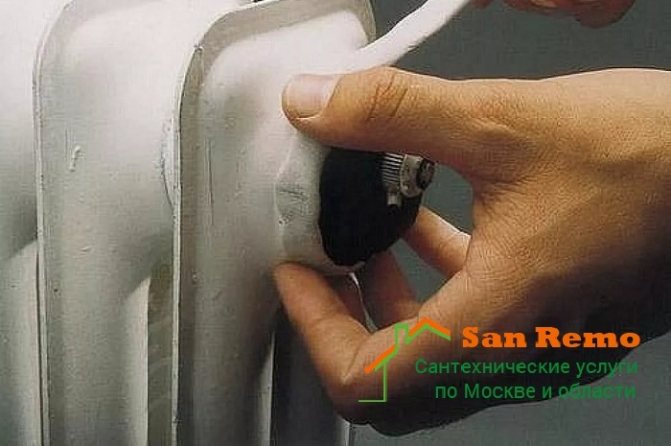

Now we will consider how and how you can seal the leak if the above cases do not fit or do not help for some reason. The main ways to solve the problem if the battery is leaking are as follows:
- Cold welding
- Application of a cement-plaster cast
- Using table salt
- Heat and moisture resistant adhesives
Cold welding
There are high strength and easy to use 2-component epoxy adhesives. A certain variation of cold welding has been created for each metal, but there are also universal options. For example, you can buy a repair rod to seal cracks, seal holes, and seal leaks in cast iron, steel, and bimetallic radiators.
Before covering up the leak, you will have to dry and degrease the surface. If necessary, remove corrosion with a brush or sandpaper. Then cold weld according to the instructions on the package.
Cement and plaster filling
If there is no cold welding, and a cast-iron or other battery has leaked heavily - what to do in this case? Use a cement-plaster cast. You will need a bandage, plaster of Paris, or cement. Dilute the dry mixture to a creamy consistency, saturate the bandage with it and wrap it over the place where the cold or hot battery flows. Apply several layers to form a strong bandage. If it is not possible to drain the coolant, replace the cement with alabaster or gypsum. It is recommended to apply 1-2 layers of a bandage impregnated with a cement mixture on top.
Table salt
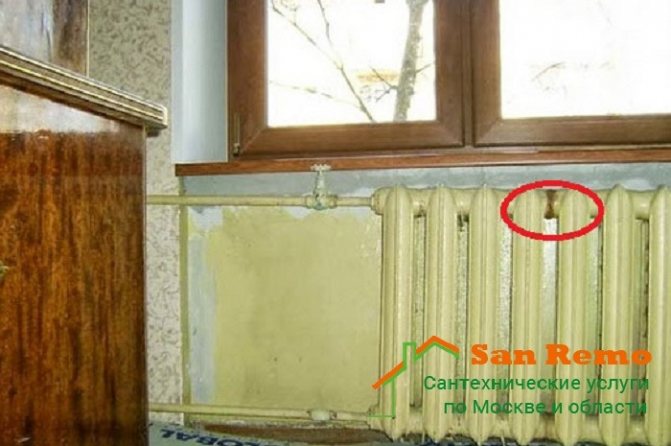

The simplest way to remove a radiator leak at home without the help of a technician is to use table salt. Suitable for threaded leaks. Soak a pharmacy bandage in water and dip in salt, then wrap it around the leaking spot. When the salt is dry, the hole will be securely closed. A cement dressing is applied on top for reliability.
Adhesives
When the leak is minor, heat and moisture resistant adhesives can be used. They are applied to gauze or bandage, and then wound on a leaking place (for example, the joint between two sections). When the glue dries, the leak will be preserved. Such repairs do not last long, therefore, after the end of the heating season and drainage of water from the system, it is better to repair the radiator in a more reliable and durable way.
If the problem could not be fixed on your own, in order to avoid trouble, it is better to contact the professionals. Masters of the San Remo company inexpensively and in a short time will eliminate the cause of the leak. And if necessary, they will install a heating radiator with high quality.
Between battery sections
If a leak appears between the sections, this means the rubber or paronite gasket has become inelastic and / or the coolant has corroded it. There is one more possible reason - corrosion "ate" the nipple. In any case, for overhaul, it is required to disassemble the heater into sections and replace the damaged part.
If the heating does not work or the radiator can be turned off without stopping the system, it is removed, disassembled, old gaskets are removed, new ones are installed and assembled again. Read how to assemble / disassemble the battery here.
If not, you can temporarily seal or close the leak. With aluminum or bimetallic radiators, this trick is very difficult to accomplish - the distance between the sections is very small. And with cast iron type MS-140 it is really possible to do it.
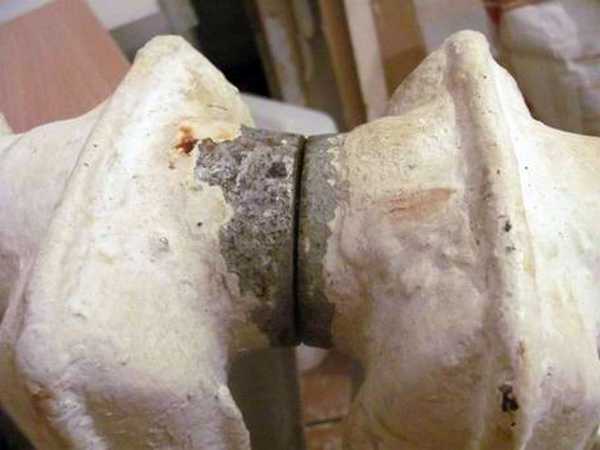

First you need to clean up the leak
First you need to clean up the place where the coolant leaks: remove everything to the metal. Where there is access, remove with a spatula or metal bristle brush. Where there is no access, we take a metal cable and peel it off with it. We pass it around the collector in the place where processing is required, and we pull it by one, then by the other end. After a while, everything that can fly off flies off.
On the cleaned surface we will lay the same composition as for pipe insulation: epoxy resin and metal powder or "cold welding". Only strips of fabric are needed that are narrower and longer. Wipe dry and clean, apply the composition, wrap it with a cloth, still spread it with glue, another turn. So 4-5 turns. Do not smear the top one. For reliability, you can pull off the top with a clamp.
If there is a ready-made iron putty, you can apply (or make) it. Then 3-4 turns of fabric, smeared with the composition, will be enough. The simplest recipe that is suitable for eliminating a leak in a cast-iron battery: add drying oil to lead red lead, grind to make a gruel. Apply it between sections. If there is white lead - mix with red lead, add drying oil. The consistency is the same: gruel.
In any case, such a radiator repair is only a temporary measure. After the heating season is over, repackaging is required.


